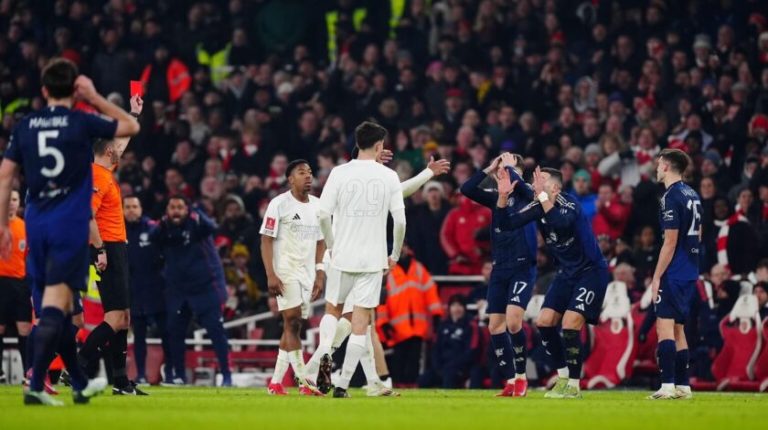Leeds United returns to the Premier League. Not many promoted teams are hot topics like Leeds in this 2020/21 season. The cause is not only the history of the club, but also the head coach: Marcelo Bielsa.
Bielsa is a crazy trainer in various meanings. One of them is in terms of tactics. Discussions about Leeds’ tactics when they were still in the Championship are familiar. In the first match against the defending Premier League champions, Liverpool, Leeds were beaten 3-4 at Anfield but the Argentina coach’s tactics stole the attention.
Offense
Leeds often tried to build attacks constructively from below. Kalvin Phillips as a defensive midfielder gave the option of progression through the middle but the other two Leeds midfielders were in the high area. There is a disconnection between the lines, but if you see this happening throughout the match, this disconnection looks like it was done on purpose.
They don’t play foot to foot from the low area until the final third of the pitch. Leeds only provoked opponents to press and try to progress to Phillips. If Phillips is left alone, he can be dangerous because he has good hull baiting accuracy. Leeds’s first goal scored through Jack Harrison’s individual action came from Phillips’s hull.
After the goal occurred, Liverpool tidied up their high pressing. Roberto Firmino did a cover shadow against Phillips so that the progression was cut off. Leeds is not without a solution, they release the bait directly forward. In these conditions, the roles of the two Leeds midfielders are quite crucial. Pablo Hernandez and Mateusz Klich’s high position made it easier for them to grab the second ball.
In this match, Leeds had the ball more with 52% possession. But that doesn’t mean Leeds build up attack patiently. They actually play fast forward.
As mentioned earlier, the Leeds players did not stop running. This constant movement has various functions, namely the opponent is hooked out of the zone, the bait option is always there, makes the situation win numbers, and attacks the space behind Liverpool’s last line.
Leeds players always make movements to get out of their original position. This idea was effective in breaking up Liverpool’s defensive formation, especially the center-back duo who were often provoked out of position so that space was created. In the process of Patrick Bamford’s goal, Joe Gomez was hooked away from the defense line. The goal was indeed Virgil Van Dijk’s mistake but it was effective in keeping the Liverpool defender off the line.
The Leeds combination game is also based on the active movements of the players. For example, at this moment when Leeds carried out a third man run scheme. Hernandez gave and go so it was difficult to be watched by Liverpool players. After getting the ball from Klich, Harrison fired the ball through Hernandez. Although it failed to become an opportunity, this scheme proved successful in penetrating Liverpool’s defense.
Additionally, the movement of Leeds players left them with many options when it reached the final third of the pitch. There are almost always five players when they reach the final third of the pitch. The result was Klich’s goal which came from Helder Costa’s cross. The more options, the more difficult it is for the opponent to guard.
Defense
Leeds adopted a radical man-to-man system. The player is not afraid to get out of position when the person being guarded moves to a different side. This tactic is high risk but the payoff is worth it if executed well.
The two moments are examples of Leeds’ radical man-to-man orientation. Stuart Dallas as left back continues to follow Salah into the center area. When there was a throw-in situation, Robin Koch, who was positioned as a center back, guarded Firmino up to the center third of the field.
Against a team of extraordinary individual quality like Liverpool, it was naive enough for Leeds to do this anyway. Leeds players often face 1v1 situations against Sadio Mane or Mo Salah, situations that are generally avoided by any team. As a result, Mane recorded five dribbles and Salah scored seven dribbles. It is interesting to see how the mid-table team looks for solutions to the Leeds defense system.
The man-to-man system guards the opposing players well but does not guard the zone. Lots of space was created that Liverpool managed to access, especially the space behind the Leeds defense which was penetrated through a diagonal through ball. Liverpool managed to create many opportunities even though they failed to be used as goals. In total Liverpool made 22 shots.
Besides the man-to-man system, another Leeds way of defense that caught the eye was high intensity when pressing. Their pressing organization looks messy like Manchester City or Liverpool, but high intensity still makes it difficult for opponents. High determination and relentless running made Leeds managed to record 34 successful tackles out of a total of 53 tackles in this match.
Transition
The counter press is Leeds’ main choice when it loses the ball. But if the opponents manage to deal with Leeds’ pressing well, they will get back to organizing the defense.
Leeds are quite vulnerable at this phase because of the active movement of their players when attacking. As a result, Leeds often lacked personnel when they were attacked back, especially the Liverpool front-line trio were extraordinary in their combination. Liverpool have a 2v1 situation when on the counter attack even though they fail to be maximized into goals.
When he managed to grab the ball, Leeds tried to counterattack. Leeds players are ready to help attack quickly so the number of players up front is quite a lot. Their counter-attack target is a through ball behind the opposing line of defense.
Set Piece
Set-piece situations have contributed to three of the four goals scored by Liverpool. Liverpool’s second goal was scored by Van Dijk from a corner. Leeds failed to anticipate Liverpool’s blocking mechanism which made Van Dijk not guarded and had room for free headers.
Leeds were also too focused on the ball so that the second ball situation was out of control. Liverpool’s third goal with Salah’s volley came from this situation. All Leeds players focused on the ball so Salah had room to shoot. Salah’s strike was extraordinary and not many players could volley like that, but Leeds still had to anticipate the second ball situation well.
Liverpool’s winning goal also came from a corner. Phillips failed to clear the ball perfectly so that the ball was still in the Leeds penalty box. All the Leeds players were glued to the ball, no one anticipated the second ball. Fabinho gets the second ball before Rodrigo commits a foul.
Set-piece situations cannot be underestimated. Last season, 21% of the total goals of all Premier League teams were scored from set pieces. Leeds does have problems when it comes to defending in set piece situations. Last season, Leeds were the fewest teams conceded with 35 goals in 46 Championship games. That record could have been much better had Leeds been able to prevent opponents from scoring with set pieces. 12 of the 35 goals scored against Leeds have come from set pieces.
Despite their status as a promotion team, Leeds have proven that they cannot be underestimated. Surprising tactics and high determination managed to get the reigning champion into a hassle. If Leeds had defended better in set piece situations, they could have stolen a point at Anfield.
The constant movement that became the basis of the Leeds attack resulted in three goals against Liverpool. It is a sign that a team with a number of star players in the defensive area is also having difficulty facing the Leeds attack. It is not impossible that Leeds can occasionally slaughter a team with a fragile defense.
Even though Liverpool failed to score from an open play situation, Liverpool still had many opportunities because the Leeds man-to-man system provided a lot of space. Bielsa needs to control this risk better, especially when facing a team with quality attacks. Leeds can be a dark horse if you can anticipate this well.
ASL
















